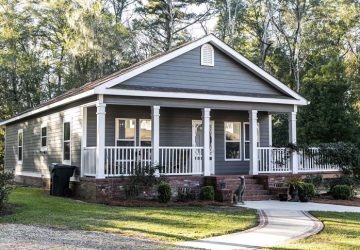Instructions to Pick the Ideal Pre-assembled Home for Your Necessities

Picking a pre-assembled home is a huge choice that includes different contemplations to guarantee it meets your particular requirements, inclinations, and way of life. This complete aide means to explore you through the basic parts of choosing a pre-assembled home that lines up with your vision, financial plan, and long haul fulfillment.
67+ Virtuoso Tricks of the trade You'll Wish You Knew Sooner
Figuring out Various Sorts: Dive more deeply into the various kinds of pre-assembled homes, like particular homes, panelized homes, and trailers homes. Measured homes comprise of different modules worked off-site and collected on your territory. Panelized homes have wall boards fabricated off-site and are gathered nearby. Trailers homes, otherwise called manufactured houses, are fabricated completely in a production line and shipped to your area. Grasping the attributes, advantages, and constraints of each will direct your dynamic interaction.
Spending plan Contemplations: Lay out an unmistakable financial plan that incorporates the expense of the home, land, site readiness, utility associations, and any extra customizations or overhauls. This clearness will help in settling on a monetarily trustworthy decision and guarantee you don't surpass your monetary capacities.
Choosing a Producer: Exploration and select a legitimate maker with a demonstrated history. Think about their experience, nature of work, guarantee contributions, and client surveys. Visiting their model homes or conversing with past clients can give important experiences into their workmanship.
Customization Choices: Investigate the customization choices accessible, guaranteeing the home can be custom-made to meet your particular inclinations, necessities, and way of life prerequisites. Examine customization prospects with the maker to make a home that really mirrors your vision.
Energy Effectiveness and Supportability: Consider the energy proficiency of the home, searching for elements like all around protected walls, energy-proficient windows, and practical materials that add to long haul reserve funds and natural manageability. Energy-effective homes decrease utility expenses as well as affect the climate.
Size and Format: Decide the size and design that will oblige your way of life and future requirements. Think about variables like the quantity of rooms, restrooms, and the progression of the living spaces. Ponder how your family could develop or change over the long run and plan appropriately.
Site Determination and Arrangement: Think about the area and the vital site planning. Guarantee the land is appropriate for the sort of pre-assembled home you are thinking about, and comprehend the expenses and cycles engaged with setting up the site. Factors like soil quality, waste, and admittance to utilities are significant contemplations.
Legitimate and Drafting Prerequisites: Explore the lawful and drafting necessities of introducing a pre-assembled home on your ideal area, guaranteeing consistence with neighboring guidelines and construction regulations. Get any important licenses and endorsements to stay away from legitimate issues not too far off.
Guarantee and After-deals Administration: Assess the guarantee and after-deals administration given by the producer, guaranteeing you will get continuous help and help post-buy. An exhaustive guarantee can give true serenity and monetary security if there should be an occurrence of unforeseen issues.
Long haul Speculation Point of view: Think about the drawn out perspectives like the home's strength, support necessities, and potential resale esteem, guaranteeing it's a beneficial venture. A very much fabricated and appropriately kept up with pre-assembled home can offer long haul solace and worth.
Producer Notoriety: Exploration and think about the standing of the maker, searching for unwavering quality and consumer loyalty. Understanding surveys, looking for proposals, and checking their history can assist you with evaluating their believability.
Customization Choices: Investigate customization choices that permit you to fit the home to your inclinations and necessities, guaranteeing it really mirrors your way of life and inclinations. Customizations can incorporate format changes, inside completions, and, surprisingly, outside feel to match your own style.
End
Picking the ideal pre-assembled home includes an all encompassing thought of different variables, including types, financial plan, customization, and manageability. This guide gives an organized way to deal with pursuing an educated and certain decision, guaranteeing that your pre-assembled home lines up with your vision, addresses your issues, and adds to a fantastic and open to residing experience.
67+ Virtuoso Tricks of the trade You'll Wish You Knew Sooner
Figuring out Various Sorts: Dive more deeply into the various kinds of pre-assembled homes, like particular homes, panelized homes, and trailers homes. Measured homes comprise of different modules worked off-site and collected on your territory. Panelized homes have wall boards fabricated off-site and are gathered nearby. Trailers homes, otherwise called manufactured houses, are fabricated completely in a production line and shipped to your area. Grasping the attributes, advantages, and constraints of each will direct your dynamic interaction.
Spending plan Contemplations: Lay out an unmistakable financial plan that incorporates the expense of the home, land, site readiness, utility associations, and any extra customizations or overhauls. This clearness will help in settling on a monetarily trustworthy decision and guarantee you don't surpass your monetary capacities.
Choosing a Producer: Exploration and select a legitimate maker with a demonstrated history. Think about their experience, nature of work, guarantee contributions, and client surveys. Visiting their model homes or conversing with past clients can give important experiences into their workmanship.
Customization Choices: Investigate the customization choices accessible, guaranteeing the home can be custom-made to meet your particular inclinations, necessities, and way of life prerequisites. Examine customization prospects with the maker to make a home that really mirrors your vision.
Energy Effectiveness and Supportability: Consider the energy proficiency of the home, searching for elements like all around protected walls, energy-proficient windows, and practical materials that add to long haul reserve funds and natural manageability. Energy-effective homes decrease utility expenses as well as affect the climate.
Size and Format: Decide the size and design that will oblige your way of life and future requirements. Think about variables like the quantity of rooms, restrooms, and the progression of the living spaces. Ponder how your family could develop or change over the long run and plan appropriately.
Site Determination and Arrangement: Think about the area and the vital site planning. Guarantee the land is appropriate for the sort of pre-assembled home you are thinking about, and comprehend the expenses and cycles engaged with setting up the site. Factors like soil quality, waste, and admittance to utilities are significant contemplations.
Legitimate and Drafting Prerequisites: Explore the lawful and drafting necessities of introducing a pre-assembled home on your ideal area, guaranteeing consistence with neighboring guidelines and construction regulations. Get any important licenses and endorsements to stay away from legitimate issues not too far off.
Guarantee and After-deals Administration: Assess the guarantee and after-deals administration given by the producer, guaranteeing you will get continuous help and help post-buy. An exhaustive guarantee can give true serenity and monetary security if there should be an occurrence of unforeseen issues.
Long haul Speculation Point of view: Think about the drawn out perspectives like the home's strength, support necessities, and potential resale esteem, guaranteeing it's a beneficial venture. A very much fabricated and appropriately kept up with pre-assembled home can offer long haul solace and worth.
Producer Notoriety: Exploration and think about the standing of the maker, searching for unwavering quality and consumer loyalty. Understanding surveys, looking for proposals, and checking their history can assist you with evaluating their believability.
Customization Choices: Investigate customization choices that permit you to fit the home to your inclinations and necessities, guaranteeing it really mirrors your way of life and inclinations. Customizations can incorporate format changes, inside completions, and, surprisingly, outside feel to match your own style.
End
Picking the ideal pre-assembled home includes an all encompassing thought of different variables, including types, financial plan, customization, and manageability. This guide gives an organized way to deal with pursuing an educated and certain decision, guaranteeing that your pre-assembled home lines up with your vision, addresses your issues, and adds to a fantastic and open to residing experience.
LATEST POSTS
- 1
 Step by step instructions to Safeguard Your Teeth During Sports Exercises
Step by step instructions to Safeguard Your Teeth During Sports Exercises - 2
 See as Your #1: These Low-Sugar Food sources You Ought to Attempt
See as Your #1: These Low-Sugar Food sources You Ought to Attempt - 3
 Instructions to Floss Appropriately and Forestall Gum Sickness
Instructions to Floss Appropriately and Forestall Gum Sickness - 4
 Web designers for Independent ventures
Web designers for Independent ventures - 5
 A definitive Manual for Picking Electric Vehicle: Decision in favor of Your Number one
A definitive Manual for Picking Electric Vehicle: Decision in favor of Your Number one
Share this article
 The most effective method to Keep up with Proficient Handshakes in a Computerized World
The most effective method to Keep up with Proficient Handshakes in a Computerized World 6 Top Computer game Control center
6 Top Computer game Control center The most effective method to Stay away from Normal Traps While Recruiting a Material Organization
The most effective method to Stay away from Normal Traps While Recruiting a Material Organization A definitive Handbook for Securities exchange Money management
A definitive Handbook for Securities exchange Money management 5 Eating routine Well disposed Snacks to Keep You Fulfilled
5 Eating routine Well disposed Snacks to Keep You Fulfilled Vote In favor of Your Favored Kind Of Attire
Vote In favor of Your Favored Kind Of Attire Favored Vehicle for Seniors: Make Your Determination
Favored Vehicle for Seniors: Make Your Determination Inside Plan with Houseplants: An Aide
Inside Plan with Houseplants: An Aide Turning into a Distributed Writer: My Composing Process
Turning into a Distributed Writer: My Composing Process













